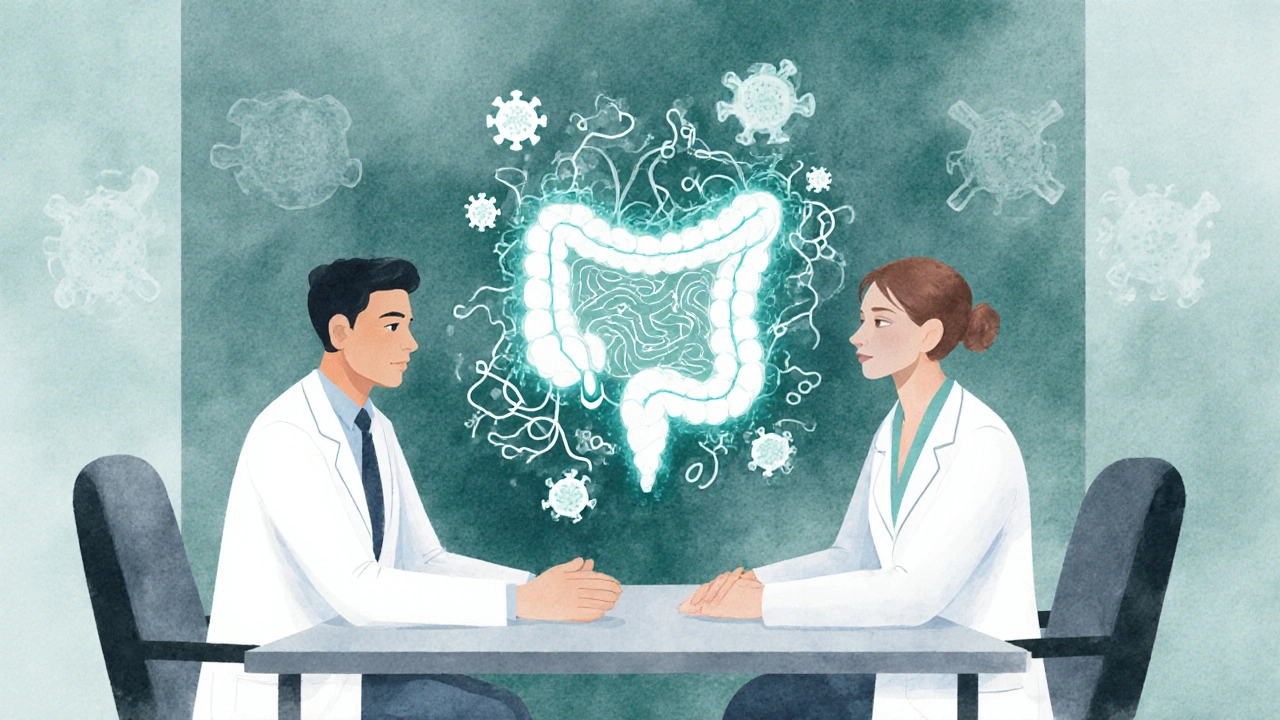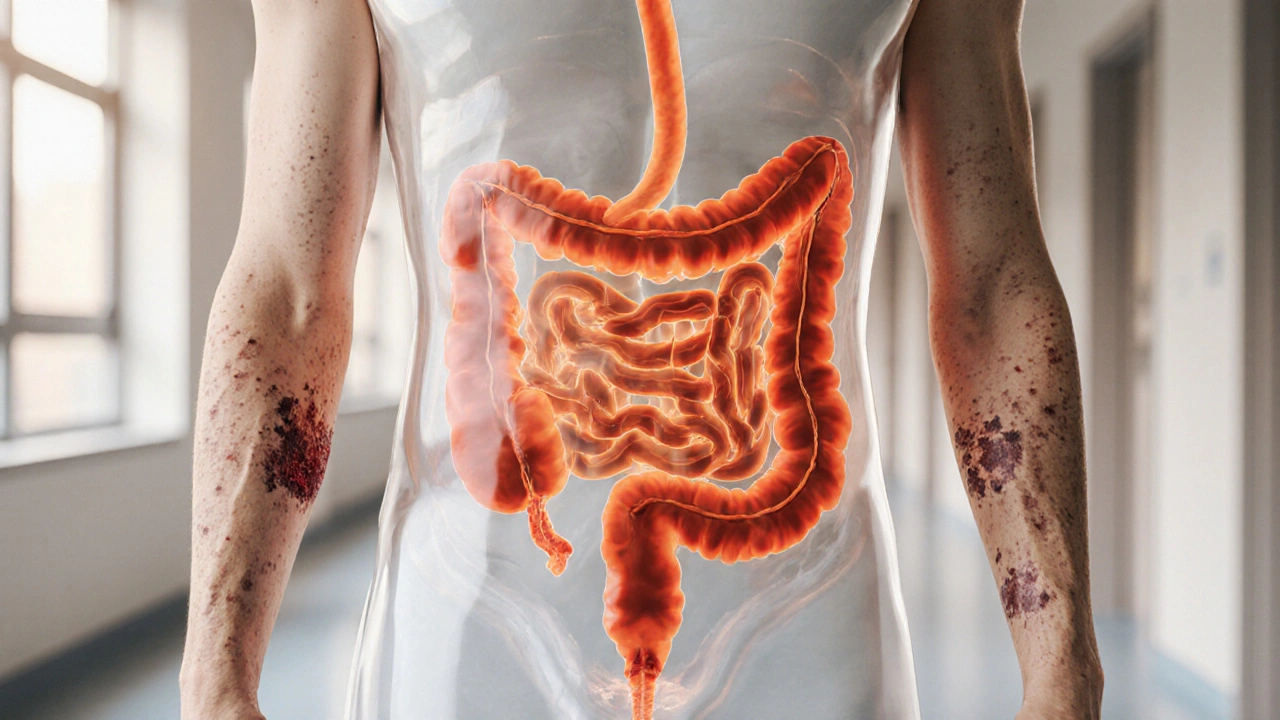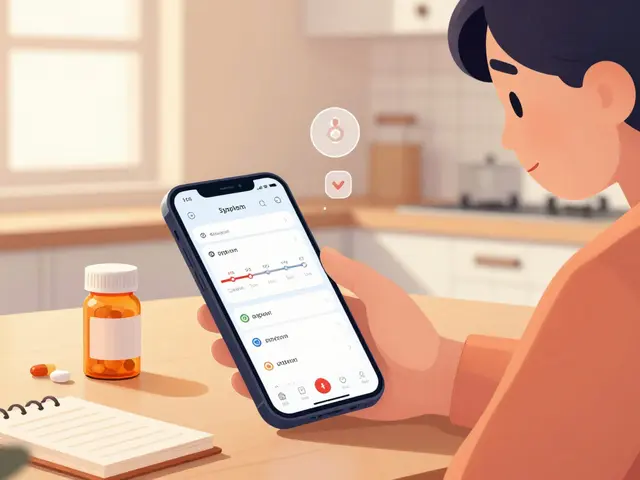Ulcerative Colitis & Skin Conditions Quiz
This interactive quiz tests your understanding of skin manifestations related to ulcerative colitis and how they're managed.
Did you know that up to 15% of people living with ulcerative colitis develop painful skin lesions? Those skin problems aren’t random- they’re a direct off‑shoot of the inflammation raging in the gut. Understanding why the colon and the skin talk to each other can help you spot trouble early and team up with the right doctors.
Key Takeaways
- Ulcerative colitis often shows up on the skin as pyoderma gangrenosum, erythema nodosum, psoriasis, vitiligo, or Sweet’s syndrome.
- The gut‑skin link is driven by immune dysregulation, shared genetics, and circulating inflammatory chemicals.
- Treating the underlying bowel disease usually eases skin flare‑ups, but targeted skin therapies are sometimes needed.
- Regular skin checks and quick treatment can prevent scarring and improve quality of life.
- Work with both a gastroenterologist and a dermatologist for coordinated care.
What Is Ulcerative Colitis?
Ulcerative colitis is a chronic inflammatory bowel disease (IBD) that exclusively affects the lining of the colon and rectum. It causes ulcerations, bleeding, and urgent bowel movements. While the primary symptoms are digestive- abdominal pain, diarrhea, and blood in stool- the disease rarely stays confined to the gut. About one in six patients experiences extraintestinal manifestations (EIMs), and the skin is the most visible of those.
Why Skin Matters: The Extraintestinal Manifestations
Extraintestinal manifestations are like side‑effects of the immune system’s over‑drive. When the colon’s immune cells go rogue, they release cytokines such as tumor necrosis factor‑alpha (TNF‑α) and interleukin‑6 (IL‑6). Those messengers travel through the bloodstream and can inflame skin, joints, eyes, and even the liver. The skin is especially vulnerable because it shares similar immune pathways with the gut.
Genetic studies have identified overlapping risk loci for ulcerative colitis and several skin disorders, suggesting a shared genetic backdrop. The gut microbiome also plays a role: an imbalance (dysbiosis) can alter skin‑friendly bacteria, further stoking inflammation.
Common Skin Conditions Linked to Ulcerative Colitis
Not every rash means you have ulcerative colitis, but there are a handful of skin problems that show up far more often in IBD patients.
Pyoderma Gangrenosum
Pyoderma gangrenosum is a rare, rapidly‑progressing ulcer that starts as a tender nodule and then breaks down into a painful, necrotic wound. It appears in 1-3% of ulcerative colitis cases and often mirrors disease activity- when the colon flares, the skin does too. The lesions have a characteristic purple border and can expand quickly if left untreated.
Erythema Nodosum
Erythema nodosum presents as firm, red‑brown bumps, usually on the shins. These nodules are tender, may bruise, and often resolve on their own within three to six weeks. About 5-10% of ulcerative colitis patients develop this condition, and it frequently coincides with active intestinal inflammation.
Psoriasis
Psoriasis is an autoimmune skin disease marked by silvery, scaly plaques on elbows, scalp, and lower back. Current data suggest that 2-5% of ulcerative colitis sufferers also have psoriasis, and the two diseases can exacerbate each other through shared cytokine pathways, especially TNF‑α.
Vitiligo
Vitiligo causes loss of pigment in patches of skin, leading to stark white spots. Although less common, vitiligo appears in roughly 1% of ulcerative colitis patients. The link appears to be an autoimmune cross‑reaction where the body attacks melanocytes the same way it attacks colon cells.
Sweet’s Syndrome
Sweet’s syndrome (acute febrile neutrophilic dermatosis) shows up as sudden, painful, red plaques that often come with fever. It is reported in 0.5-1% of IBD cases and responds quickly to steroids.
How the Immune System Bridges Gut and Skin
Three main mechanisms explain the gut‑skin connection:
- Cytokine spillover: Inflamed colon tissue releases TNF‑α, IL‑1β, and IL‑6 into the bloodstream. Those cytokines recruit neutrophils and other immune cells to the skin, sparking lesions.
- Shared genetic susceptibility: Genes like NOD2, IL23R, and HLA‑B27 increase risk for both ulcerative colitis and skin autoimmunity.
- Microbiome cross‑talk: Dysbiosis in the gut can alter metabolites (short‑chain fatty acids) that normally help keep skin inflammation in check.
Because the pathways overlap, therapies that quiet gut inflammation often calm skin flare‑ups as well.

Managing Skin Symptoms: Practical Tips
While you’re waiting for a specialist appointment, these steps can keep skin issues from spiraling:
- Track flares: Note when skin lesions appear relative to bowel symptoms. A simple diary helps your doctor see patterns.
- Gentle skin care: Use fragrance‑free cleansers, lukewarm water, and moisturize immediately after bathing to preserve barrier function.
- Avoid trauma: Even a small scratch can trigger pyoderma gangrenosum (a phenomenon called pathergy).
- Nutrition support: Omega‑3 fatty acids, vitamin D, and zinc have modest evidence for skin healing. Talk to a dietitian about a gut‑friendly, anti‑inflammatory diet.
- Medication review: Some ulcerative colitis drugs (like sulfasalazine) can cause photosensitivity. Adjust timing or use sunscreen if needed.
Targeted Treatments
When skin lesions are mild, topical steroids or calcineurin inhibitors may suffice. For moderate to severe cases, systemic therapy is often required.
TNF inhibitors (e.g., infliximab, adalimumab) block the key cytokine driving both gut and skin inflammation. Clinical trials show that up to 70% of ulcerative colitis patients with pyoderma gangrenosum experience skin healing after starting a TNF inhibitor.
Alternative biologics targeting interleukin‑12/23 (ustekinumab) or Janus kinases (tofacitinib) have also demonstrated benefit for co‑occurring psoriasis and ulcerative colitis.
When to Seek Professional Help
If you notice any of the following, make an appointment promptly:
- Rapidly expanding skin ulcer or wound that doesn’t improve after a few days.
- Severe pain, fever, or drainage from a lesion.
- New‑onset rash that covers large areas or spreads quickly.
- Any skin change that coincides with a worsening of bowel symptoms.
Ideally, you’ll work with a gastroenterologist who can adjust your IBD regimen and a dermatologist who can prescribe skin‑specific therapies. Coordinated care reduces the risk of scarring and improves overall well‑being.
Comparison of Common Skin Manifestations
| Condition | Typical Prevalence in UC | Main Symptoms | First‑line Treatment |
|---|---|---|---|
| Pyoderma gangrenosum | 1-3% | Painful, rapidly expanding ulcer with purple border | Systemic steroids or TNF inhibitors |
| Erythema nodosum | 5-10% | Tender red‑brown nodules on shins | Address gut flare; NSAIDs or colchicine |
| Psoriasis | 2-5% | Silvery, scaly plaques on elbows, scalp | Topical steroids; biologics if severe |
| Vitiligo | ~1% | Well‑defined white patches | Topical calcineurin inhibitors; phototherapy |
| Sweet’s syndrome | 0.5-1% | Sudden painful red plaques, often with fever | Systemic steroids |
Bottom Line
Skin problems aren’t an afterthought for people with ulcerative colitis-they’re a tell‑tale sign that the same immune fire burning inside your gut is spilling over. Recognizing the patterns, keeping a symptom log, and getting help from both a gastroenterologist and a dermatologist can keep those lesions from turning into permanent scars.
Frequently Asked Questions
Can ulcerative colitis cause rashes that look like eczema?
Eczema‑type rashes aren’t a classic extraintestinal manifestation, but some IBD patients report eczema‑like patches, usually linked to medication side‑effects or a secondary allergic response. If the rash appears with a bowel flare, it’s worth asking your doctor whether it’s an IBD‑related skin issue.
Why does pyoderma gangrenosum worsen when I get a minor cut?
This phenomenon is called pathergy. In pyoderma gangrenosum, the immune system overreacts to trauma, releasing neutrophils that create a rapidly expanding ulcer. Avoid unnecessary skin trauma and keep cuts clean.
Are biologic drugs safe for long‑term skin health?
Biologics that target TNF‑α, IL‑12/23, or JAK pathways have well‑documented safety profiles spanning several years. They can actually improve skin health by dampening the same inflammatory signals that cause lesions. Regular monitoring for infections and blood work is still essential.
Can diet alone reduce skin flare‑ups?
Diet isn’t a cure, but a low‑FODMAP or specific anti‑inflammatory diet can lower gut inflammation, which in turn may calm skin symptoms. Adding omega‑3 rich foods (salmon, flaxseed) and ensuring adequate vitamin D are practical steps.
Should I see a dermatologist if my ulcerative colitis is in remission?
Yes. Some skin manifestations can appear even when the bowel looks quiet, especially conditions like vitiligo or psoriasis. A dermatologist can screen for early signs and suggest preventive care.




angelica maria villadiego españa on 29 September 2025, AT 22:51 PM
I totally get how scary those skin lesions can feel. It’s amazing how the gut and skin talk to each other, and spotting the signs early can really help. Keeping a simple diary of your bowel and skin changes is a good first step. If you notice a new rash when your UC flares, let your doctor know right away. You don’t have to go through it alone.